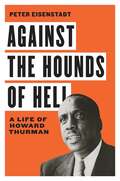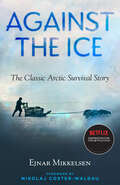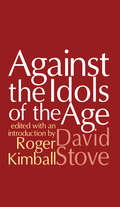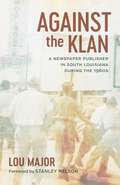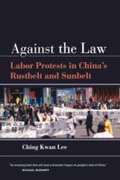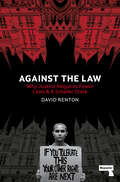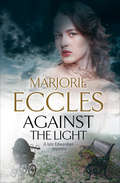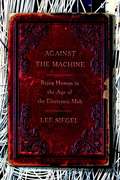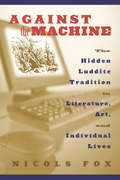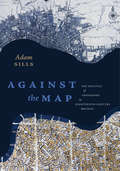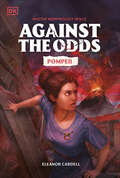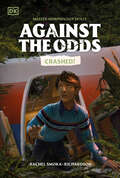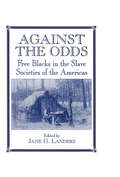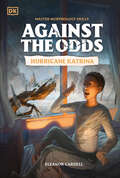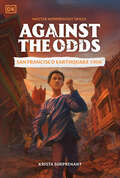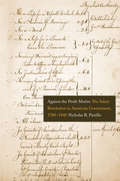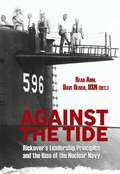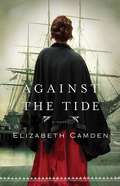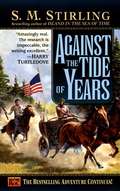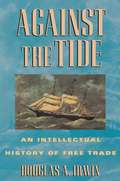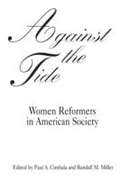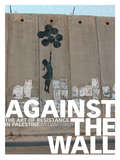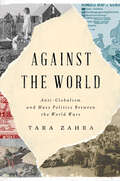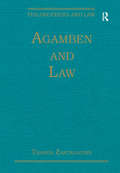- Table View
- List View
Against the Hounds of Hell: A Life of Howard Thurman (The American South Series)
by Peter EisenstadtAn inspiration to Martin Luther King Jr., James Farmer, and other leaders of the civil rights movement, Howard Thurman was a crucial figure in the advancement of African Americans in the 20th century. Until now, however, he has not received the full biographical treatment he deserves. In Against the Hounds of Hell, Thurman scholar Peter Eisenstadt offers a fascinating exploration of the life of this great religious thinker and activist. The first significant African American pacifist, Thurman was the first African American to meet Mahatma Gandhi. An early and outspoken feminist, environmentalist, and advocate for social and economic justice, he was one of the first and most insistent mid-20th century proponents of racial integration. At the same time, he was a key figure in the emergence of mysticism and "spirituality" as an alternative to formal religion. Against the Hounds of Hell will at last establish this multifaceted historical personage as a leading figure of 20th century American politics, religion, and culture.
Against the Ice: The Classic Arctic Survival Story
by Ejnar MikkelsenSoon to be a Netflix feature film co-written by and starring Nikolaj Coster-Waldau (Game of Thrones) The harrowing, amazing, and often amusing personal account of two mismatched Arctic explorers who banded together to keep themselves sane on an historic expedition gone horribly wrongEjnar Mikkelsen was devoted to Arctic exploration. In 1910 he decided to search for the diaries of the ill-fated Mylius-Erichsen expedition, which had set out to prove that Robert Peary&’s outline of the East Greenland coast was a myth, erroneous and presumably self-serving. Iver Iversen was a mechanic who joined Mikkelsen in Iceland when the expedition&’s boat needed repair. Several months later, Mikkelsen and Iversen embarked on an incredible journey during which they would suffer every imaginable Arctic travail: implacable cold, scurvy, starvation, frostbite, snow blindness, plunges into icy seawater, impossible sledding conditions, Vitamin A poisoning, debilitated dogs, apocalyptic storms, gaping crevasses, and assorted mortifications of the flesh. Mikkelsen&’s diary was even eaten by a bear. Three years of this, coupled with seemingly no hope of rescue, would drive most crazy, yet the two retained both their sanity as well as their humor. Indeed, what may have saved them was their refusal to become as desolate as their surroundings… Nikolaj Coster-Waldau, who co-adapted the book into a screenplay, provides a new foreword to this brand-new edition of the classic exploration memoir, which was one of The Explorer's Club&’s 100 Best Books of the 20th Century. Originally published as Two Against the Ice: A Classic Arctic Survival Story and a Remarkable Account of Companionship in the Face of Adversity. Translated from the Danish by Maurice Michael.
Against the Idols of the Age
by David StoveLittle known outside his native Australia, David Stove was one of the most illuminating and brilliant philo-sophical essayists of the postwar era. A fearless at-tacker of intellectual and cultural orthodoxies, Stove left powerful critiques of scientific irrationalism, Dar-winian theories of human behavior, and philosophi-cal idealism. He was also an occasional essayist of considerable charm and polemical snap. Stove's writ-ing is both rigorous and immensely readable. It is, in the words of Roger Kimball, "an invigorating blend of analytic lucidity, mordant humor, and an amount of common sense too great to be called 'common.'" Against the Idols of the Age brings together a repre-sentative selection of Stove's writing and is an ideal introduction to his work.The book opens with some of Stove's most impor-tant attacks on irrationalism in the philosophy of sci-ence. He exposes the roots of this fashionable attitude, tracing it through writers like Paul Feyerabend andThomas Kuhn to Karl Popper. Stove was a born controversialist, so it is not surpris-ing that when he turned his attention to contemporary affairs he said things that are politically incorrect. The topical essays that make up the second part of the book show Stove at his most withering and combative. Whether the subject is race, femi-nism, the Enlightenment, or the demand for "non-coercive philosophy," Stove is on the mark with a battery of impressive arguments expressed in sharp, uncompromis-ing prose. Against the Idols of the Age concludes with a generous sampling of his blistering attacks on Darwinism.David Stove's writings are an undiscovered treasure. Although readers may dis-agree with some of his opinions, they will find it difficult to dismiss his razor-sharp arguments. Against the Idols of the Age is the first book to make the full range of this important thinker available to the general reader.
Against the Klan: A Newspaper Publisher in South Louisiana during the 1960s (Media and Public Affairs)
by Lou MajorIn 1964, less than one year into his tenure as publisher of the Bogalusa Daily News, New Orleans native Lou Major found himself guiding the newspaper through a turbulent period in the history of American civil rights. Bogalusa, Louisiana, became a flashpoint for clashes between African Americans advocating for equal treatment and white residents who resisted this change, a conflict that generated an upsurge in activity by the Ku Klux Klan. Local members of the KKK stepped up acts of terror and intimidation directed against residents and institutions they perceived as sympathetic to civil rights efforts. During this turmoil, the Daily News took a public stand against the Klan and its platform of hatred and white supremacy.Against the Klan, Major’s memoir of those years, recounts his attempts to balance the good of the community, the health of the newspaper, and the safety of his family. He provides an in-depth look at the stance the Daily News took in response to the city’s civil rights struggles, including the many fiery editorials he penned condemning the KKK’s actions and urging peaceful relations in Bogalusa. Major’s richly detailed personal account offers a ground-level view of the challenges local journalists faced when covering civil rights campaigns in the Deep South and of the role played by the press in exposing the nefarious activities of hate groups such as the Klan.
Against the Law
by Ching Kwan LeeThis study opens a critical perspective on the slow death of socialism and the rebirth of capitalism in the world's most dynamic and populous country. Based on remarkable fieldwork and extensive interviews in Chinese textile, apparel, machinery, and household appliance factories, Against the Law finds a rising tide of labor unrest mostly hidden from the world's attention. Providing a broad political and economic analysis of this labor struggle together with fine-grained ethnographic detail, the book portrays the Chinese working class as workers' stories unfold in bankrupt state factories and global sweatshops, in crowded dormitories and remote villages, at street protests as well as in quiet disenchantment with the corrupt officialdom and the fledgling legal system.
Against the Law: Why Justice Requires Fewer Laws and a Smaller State
by David RentonOne of Britain&’s leading barristers argues for a world in which the law should play a smaller part in all our lives.Understanding the main political projects of our times, and their plans to expand or shrink the law, is the first step towards achieving greater equality and averting climate disaster.Since 2016, Britain has been ruled by populists, who promise to expand democracy and shrink the law by taking back power from the European Union. Yet what these populists have actually done in power is institute a vast increase in new laws, made by ministers and not Parliament, regulating every aspect of our lives.This move of promising less law while actually expanding it, has been characteristic of our lives for forty years, ever since the neoliberal counter-revolution. Every year, new criminal offences are created; new regulations are introduced. Renton&’s book dares us to imagine a world in which workers are winning, and ecocide treated with the urgency that it deserves. These changes can only come about, he argues, if the movements of the oppressed choose to disengage from the law.
Against the Light: A Late Edwardian Mystery
by Marjorie EcclesPersonal and political tensions collide when a baby is kidnapped in an absorbing historical whodunit from the author of the Gil Mayo Mysteries. London, April, 1912. The third Irish Home Rule Bill is passing through Parliament and the situation is growing ever tense. Closely involved in the negotiations, cabinet minister Edmund Latimer finds himself under growing pressure—which only intensifies when his seven-month-old niece Lucy is snatched away in her pram in Regent&’s Park. Could there be a connection between Lucy&’s kidnapping and the Irish talks? With her husband under intolerable strain, Edmund&’s wife Alice makes it her business to find out. But the more she discovers, the more she realizes how little she really knows the man she married five years before. &“A strong storyline and plenty of interesting characters.&” —Kirkus Reviews &“[A] socially illuminating standalone from Eccles.&” —Publishers Weekly &“Here [Eccles] has commendably portrayed life in the Edwardian era, including the public&’s anxieties stemming from the labor strikes, the suffragette movement, the Irish question, and talk of war in Europe. . . . An enjoyable read.&” —Historical Novel Society
Against the Machine: Being Human in the Age of the Electronic Mob
by Lee SiegelThe new situation doesn't represent the lack of community suddenly produced by the Internet. That is the hackneyed complaint made, again and again, by people who don't seem to have thought through the unlovely aspects of community- its smug provincialism and punitive conventionalism, its stasis and xenophobia- which was in any case jeopardized and transformed by the advent of modernity two hundred years ago. The simple fact is that sometimes you don't want the quiet conformities induced by community; sometimes you simply want to be alone, yet together with other people at the same time. The old-fashioned cafe provided a way to both share and abandon solitude, a fluid, intermediary experience that humans are always trying to create and perfect. The Internet could have been its fulfillment. But sitting absorbed in your screen world is a whole other story. You are socially and psychologically cut off from your fellow caffeine addicts, but mentally beset by e-mails, commercial pop-ups, and a million temptations that may enchant in the moment- aimed as they are at your specific and immediate interests and desires -but in retrospect are time-wasting ephemera.
Against the Machine: The Hidden Luddite Tradition in Literature, Art, and Individual Lives
by Nicols FoxFrom the cars we drive to the instant messages we receive, from debate about genetically modified foods to astonishing strides in cloning, robotics, and nanotechnology, it would be hard to deny technology's powerful grip on our lives. To stop and ask whether this digitized, implanted reality is quite what we had in mind when we opted for progress, or to ask if we might not be creating more problems than we solve, is likely to peg us as hopelessly backward or suspiciously eccentric. Yet not only questioning, but challenging technology turns out to have a long and noble history.In this timely and incisive work, Nicols Fox examines contemporary resistance to technology and places it in a surprising historical context. She brilliantly illuminates the rich but oftentimes unrecognized literary and philosophical tradition that has existed for nearly two centuries, since the first Luddites--the ""machine breaking"" followers of the mythical Ned Ludd--lifted their sledgehammers in protest against the Industrial Revolution. Tracing that current of thought through some of the great minds of the 19th and 20th centuries--William Blake, Mary Shelley, Charles Dickens, John Ruskin, William Morris, Henry David Thoreau, Ralph Waldo Emerson, Robert Graves, Aldo Leopold, Rachel Carson, and many others--Fox demonstrates that modern protests against consumptive lifestyles and misgivings about the relentless march of mechanization are part of a fascinating hidden history. She shows as well that the Luddite tradition can yield important insights into how we might reshape both technology and modern life so that human, community, and environmental values take precedence over the demands of the machine.In Against the Machine, Nicols Fox writes with compelling immediacy--bringing a new dimension and depth to the debate over what technology means, both now and for our future.
Against the Map: The Politics of Geography in Eighteenth-Century Britain
by Adam SillsOver the course of the seventeenth and eighteenth centuries, the increasing accuracy and legibility of cartographic projections, the proliferation of empirically based chorographies, and the popular vogue for travel narratives served to order, package, and commodify space in a manner that was critical to the formation of a unified Britain. In tandem with such developments, however, a trenchant anti-cartographic skepticism also emerged. This critique of the map can be seen in many literary works of the period that satirize the efficacy and value of maps and highlight their ideological purposes. Against the Map argues that our understanding of the production of national space during this time must also account for these sites of resistance and opposition to hegemonic forms of geographical representation, such as the map.This study utilizes the methodologies of critical geography, as well as literary criticism and theory, to detail the conflicted and often adversarial relationship between cartographic and literary representations of the nation and its geography. While examining atlases, almanacs, itineraries, and other materials, Adam Sills focuses particularly on the construction of heterotopias in the works of John Bunyan, Aphra Behn, Jonathan Swift, Daniel Defoe, Samuel Johnson, and Jane Austen. These "other" spaces, such as neighborhood, home, and country, are not reducible to the map but have played an equally important role in the shaping of British national identity. Ultimately, Against the Map suggests that nation is forged not only in concert with the map but, just as important, against it.
Against the Odds Pompeii (Against the Odds)
by DKThis historical fiction chapter book series features decodable tales of survival against the odds for children aged 10-14Against the Odds: Pompeii is part of the new Against the Odds series, a captivating collection of fiction books inspired by true events. In this instalment, Mount Vesuvius is erupting! Ash is falling like snow and thirteen-year-old Fabia knows something is terribly wrong. Will she escape Pompeii in time to survive this epic disaster?Each title in this collection unravels the extraordinary experiences of young people overcoming incredible challenges. Whether it’s facing the unknown or triumphing against the odds, these stories are both riveting and inspiring.This historical learn-to-read series for children offers:Popular and captivating topics featured in a historical fiction chapter book series. Decodable text in Hi-Lo style that makes the story accessible for striving readers.A focus on prefixes, suffixes, and word roots that enhances decoding, spelling, and vocabulary.Engaging stories that follow historical fiction narratives–inspired by true events–to engage and motivate reluctant readers.The Against the Odds series focuses on morphology, which is largely important for improving spelling and reading comprehension. Pompeii focuses on multiple common noun suffixes. to empower children to become fluent independent readers. Serving as a vital bridge between decodable and mainstream books, this book will empower readers to confidently understand the meaning from text alone.
Against the Odds: Crashed (Against the Odds)
by DKThis historical fiction chapter book series features decodable tales of survival against the odds for children aged 10-14Against the Odds: Crashed is part of the new Against the Odds series, a captivating collection of fiction books inspired by true events. In this instalment, three young people’s bravery is seriously put to the test in these gripping stories about real-life crash landings.Each title in this collection unravels the extraordinary experiences of young people overcoming incredible challenges. Whether it’s facing the unknown or triumphing against the odds, these stories are both riveting and inspiring.This historical learn-to-read series for children offers:Popular and captivating topics featured in a historical fiction chapter book series. Decodable text in Hi-Lo style that makes the story accessible for striving readers.A focus on prefixes, suffixes, and word roots that enhances decoding, spelling, and vocabulary.Engaging stories that follow historical fiction narratives–inspired by true events–to engage and motivate reluctant readers.The Against the Odds series focuses on morphology, which is largely important for improving spelling and reading comprehension. Crashed focuses on suffixes that mean ‘the state or result of’ to empower children to become fluent independent readers. Serving as a vital bridge between decodable and mainstream books, this book will empower readers to confidently understand the meaning from text alone.
Against the Odds: Free Blacks in the Slave Societies of the Americas
by Jane G. LandersThe seven contributions contained in this collection address various forms of manumission throughout the American South as well as the Caribbean. Topics include color, class, and identity on the eve of the Haitian revolution; where free persons of color stood in the hierarchy of wealth in antebellum
Against the Odds: Hurricane Katrina
by DKThis historical fiction chapter book series features decodable tales of survival against the odds for children aged 10-14Against the Odds: Hurricane Katrina is part of the new Against the Odds series, a captivating collection of learn-to-read fiction books inspired by true events. In this instalment, Hurricane Katrina hits the city of New Orleans, Jake and his grandma are stranded in their home. How will they escape the rising floodwaters and avoid the chaos and destruction that follows?Each title in this collection unravels the extraordinary experiences of young people overcoming incredible challenges. Whether it’s facing the unknown or triumphing against the odds, these stories are both riveting and inspiring.This learn-to-read series for children offers:Popular and captivating topics featured in a historical fiction chapter book series.Decodable text in Hi-Lo style that makes the story accessible for striving readers.A focus on prefixes, suffixes, and word roots that enhances decoding, spelling, and vocabulary.Engaging stories that follow historical fiction narratives–inspired by true events–to engage and motivate reluctant readers.The Against the Odds series focuses on morphology, which is largely important for improving spelling and reading comprehension. Against the Odds: Hurricane Katrina focuses on \negative prefixes to empower children to become fluent, independent readers. Serving as a vital bridge between decodable and mainstream books, this book will empower readers to confidently understand the meaning from text alone.
Against the Odds: San Francisco Earthquake 1906 (Against the Odds)
by DKThis historical fiction chapter book series features decodable tales of survival against the odds for children aged 10-14Against the Odds: San Francisco Earthquake 1906 is part of the new Against the Odds series, a captivating collection of fiction books inspired by true events. In this installment, fifteen-year-old Chen finds himself in the middle of the deadliest earthquake in US history.Each title in this collection unravels the extraordinary experiences of young people overcoming incredible challenges. Whether it’s facing the unknown or triumphing against the odds, these stories are both riveting and inspiring.This historical learn-to-read series for children offers:Popular and captivating topics featured in a historical fiction chapter book series.Decodable text in Hi-Lo style that makes the story accessible for striving readers.A focus on prefixes, suffixes, and word roots that enhances decoding, spelling, and vocabulary.Engaging stories that follow historical fiction narratives - inspired by true events - to engage and motivate reluctant readers.The Against the Odds series focuses on morphology, which is largely important for improving spelling and reading comprehension. San Francisco Earthquake 1906 focuses on common prefixes and verb suffixes to empower children to become fluent independent readers.
Against the Profit Motive
by Nicholas R. ParrilloIn America today, a public official’s lawful income consists of a salary. But until a century ago, the law frequently provided for officials to make money on a profit-seeking basis. Prosecutors won a fee for each defendant convicted. Tax collectors received a percentage of each evasion uncovered. Naval officers took a reward for each ship sunk. Numerous other officers were likewise paid for #147;performance. ” This book is the first to document the American government’s for-profit past, to discover how profit-seeking defined officialdom’s relationship to the citizenry, and to explain how lawmakers#151;by ultimately banishing the profit motive in favor of the salary#151;transformed that relationship forever.
Against the Tide
by Dave OliverAdmiral Hyman Rickover personally revolutionized naval warfare and altered the outcome of the Cold War. Concurrently he drove innovation into American industry -- which in the decades since has proven to be a wellspring of power for American technology. As a touchstone of his success, during Rickover's stewardship the Russians had literally dozens of reactor accidents, but Rickover's single-minded focus on safety protected Americans as well as and our lands from nuclear contamination.Rickover did all of this initially by the force of his own personality and eventually by insisting on radical culture change. The author had the good fortune to personally know and be involved with Admiral Rickover as well as many of the most interesting players and protagonists during much of this thirty year process of wrenching cultural upheaval. The author leaves detailed biographical details of Rickover to others, instead focusing on previously unknown historical events in which he personally participated or had unique knowledge which highlight the management and leadership principles behind Rickover's achievements and place important events (President Eisenhower choosing nuclear submarines to counter Sputnik, development of the Polaris Fleet, the relationship of Admirals Zumwalt and Rickover, the loss of USS Scorpion, the superiority of the American submarines over the Soviet fleet, etc.) in an historical perspective.Because of his life's work, the author is uniquely qualified to apply many of Rickover's principles to other situations. For example, Dave well understands the particular navy culture Rickover had to destroy for the author began his own career on a diesel boat. Similarly since the author spent a decade in US industry as either the Chief Executive Officer or the Chief Operating Officer, he understands how to identify situations where Rickover's principles can be applied to industry circumstances. This is done at the end of each chapter in the book, thus providing a starting point for any who wish to use this source for case studies.
Against the Tide
by Elizabeth Camden2013 RITA Winner for Inspirational Romance2013 Christy Award Winner for Historical Romance2013 Daphne du Maurier Award Winner for Inspirational Romantic Mystery/Suspense After a childhood rampant with uncertainty, Lydia Pallas has carved out a perfect life for herself. She spends her days within sight of the bustling Boston Harbor, where her skill with languages has landed her an enviable position as a translator for the U. S. Navy. Lydia's talents bring her to the attention of Alexander Banebridge, a mysterious man in need of a translator. Driven by a campaign to end the opium trade, Bane is coolly analytical and relentless in his quest. He cannot afford to fall for Lydia and must fight the bittersweet love growing between them. When Bane's enemies gain the upper hand, he is forced to turn to Lydia for help. Determined to prove her worth, Lydia soon discovers that carrying out Bane's mission will test her wits and her courage to the very limits.
Against the Tide of Years: A Novel of the Change (Island #2)
by S. M. StirlingAgainst the Tide of Years continues the adventures of the Nantucket residents who have been transported through time to the Bronze Age. In the years since their arrival, the fledging Republic of Nantucket has striven to better the primitive world in which they now exist. Their prime concerns are establishing a constitution and handling the waves of immigrants from the British Isles. But a renegade time traveler plans his own future by forging an empire for himself based on conquest by modern technology. The Republic has no alternative but to face the inevitable war brought on by one of their own....
Against the Tide: An Intellectual History of Free Trade
by Douglas A. IrwinAbout two hundred years ago, largely as a result of Adam Smith's Wealth of Nations, free trade achieved an intellectual status unrivaled by any other doctrine in the field of economics. What accounts for the success of free trade against then prevailing mercantilist doctrines? And how well has free trade withstood various theoretical attacks that have challenged it since Adam Smith's time? In this readable intellectual history, Douglas Irwin explains how the idea of free trade has endured against the tide of the abundant criticisms that have been leveled against it from the ancient world and Adam Smith's day to the present. An accessible, nontechnical look at one of the most important concepts in the field of economics, Against the Tide will allow the reader to put the ever new guises of protectionist thinking into the context of the past and discover why the idea of free trade has so successfully prevailed over time. Irwin traces the origins of the free trade doctrine from premercantilist times up to Adam Smith and the classical economists. In lucid and careful terms he shows how Smith's compelling arguments in favor of free trade overthrew mercantilist views that domestic industries should be protected from import competition. Once a presumption about the economic benefits of free trade was established, various objections to free trade arose in the form of major arguments for protectionism, such as those relating to the terms of trade, infant industries, increasing returns, wage distortions, income distribution, unemployment, and strategic trade policy. Discussing the contentious historical controversies surrounding each of these arguments, Irwin reveals the serious analytical and practical weaknesses of each, and in the process shows why free trade remains among the most durable and robust propositions that economics has to offer for the conduct of economic policy.
Against the Tide: Women Reformers in American Society
by Randall M. Miller Paul A. CimbalaAgainst the Tide is a collection of in-depth biographical essays on the most important women reformers in American history. This reader will be useful in any history course that deals with the important contributions made by women to the development of our government and society from the early republic to today. The volume combines scholarly vitality with readability, making it appropriate for all levels of students.
Against the Wall: The Art of Resistance in Palestine
by William ParryFeaturing the work of acclaimed artists such as Banksy, Ron English, and Blu, as well as Palestinian artists and activists, the photographs in this collection express outrage, compassion, and touching humor while illustrating the lives and livelihoods of the tens of thousands of people affected by Israel's wall. This stunning book of photographs details the graffiti and art that have transformed Israel's Wall of Separation into a canvas of symbolic resistance and solidarity. The compelling images are interspersed with vignettes of the people whose lives are affected by the wall and who suffer due to a lack of work, education, and vital medical care.
Against the Wind
by Bodie Thoene Brock ThoeneAs Nazi forces tighten their net of evil over Europe in 1940, famed Jewish concert violist Elisa Lindheim Murphy escapes from Vienna to England. But both Elisa and her American newsman husband, John Murphy, are convinced that nowhere in Europe is safe from HitlerÂ's seemingly unstoppable forces. As Nazi U-boats patrol and sink Allied vessels in the North Atlantic, Elisa makes a desperate but brave decision ;to accompany Jewish refugee children on a civilian transport through treacherous seas to seek asylum in America. At least there, in the land of freedom, the ragged remnant of the Jewish people can live on in peace and safety ;or so she hopes. But as German torpedoes streak toward the refugee ship, Elisa will face the greatest trial of her life.
Against the World: Anti-Globalism and Mass Politics Between the World Wars
by Tara ZahraA brilliant, eye-opening work of history that speaks volumes about today’s battles over international trade, immigration, public health and global inequality. Before the First World War, enthusiasm for a borderless world reached its height. International travel, migration, trade, and progressive projects on matters ranging from women’s rights to world peace reached a crescendo. Yet in the same breath, an undercurrent of reaction was growing, one that would surge ahead with the outbreak of war and its aftermath. In Against the World, a sweeping and ambitious work of history, acclaimed scholar Tara Zahra examines how nationalism, rather than internationalism, came to ensnare world politics in the early twentieth century. The air went out of the globalist balloon with the First World War as quotas were put on immigration and tariffs on trade, not only in the United States but across Europe, where war and disease led to mass societal upheaval. The “Spanish flu” heightened anxieties about porous national boundaries. The global impact of the 1929 economic crash and the Great Depression amplified a quest for food security in Europe and economic autonomy worldwide. Demands for relief from the instability and inequality linked to globalization forged democracies and dictatorships alike, from Gandhi’s India to America’s New Deal and Hitler’s Third Reich. Immigration restrictions, racially constituted notions of citizenship, anti-Semitism, and violent outbursts of hatred of the “other” became the norm—coming to genocidal fruition in the Second World War. Millions across the political spectrum sought refuge from the imagined and real threats of the global economy in ways strikingly reminiscent of our contemporary political moment: new movements emerged focused on homegrown and local foods, domestically produced clothing and other goods, and back-to-the-land communities. Rich with astonishing detail gleaned from Zahra’s unparalleled archival research in five languages, Against the World is a poignant and thorough exhumation of the popular sources of resistance to globalization. With anti-globalism a major tenet of today’s extremist agendas, Zahra's arrestingly clearsighted and wide-angled account is essential reading to grapple with our divided present.
Agamben and Law: Power, Law And The Uses Of Criticism (Philosophers And Law Ser.)
by Thanos ZartaloudisThis collection of articles brings together a selection of previously published work on Agamben‘s thought in relation to law and gathered from within the legal field and theory in particular. The volume offers an exemplary range of varied readings, reflections and approaches which are of interest to readers, students and researchers of Agamben‘s law-related work.
